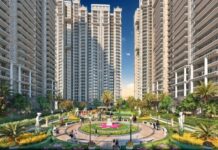By Tapaswini Mohapatra Samant Architect, Environment Designer, Sustainable Architect
New Delhi, June 11, 2018: The mission of development of 50 million homes by 2022 and 90 smart cities has already in drive. Out of this requirement, EWS (economically weaker sections) and LIG (lower income groups) account for 95% of the total. To achieve such a vast achievement in a short time, industry experts point out that advance technologies which will aid in the fast construction. One of the techniques which have become very adaptable is offsite construction and pre-fabricated modular units. Prefabricated construction technology is one area the government & builders are strongly stepping upon.
 The concept of precast (also known as “prefabricated”) construction includes those buildings where the majority of structural components are standardized and produced in plants in a location away from the building, and then transported to the site for assembly .
The concept of precast (also known as “prefabricated”) construction includes those buildings where the majority of structural components are standardized and produced in plants in a location away from the building, and then transported to the site for assembly .
Can prefab construction make homes more affordable & usable?
There is growing realization today that speed of construction needs to be given greater importance especially for large housing projects. For undertaking mass housing works, it is necessary to have innovative technologies which are capable of fast rate construction and are able to deliver good quality and durable structure in cost effective manner.
Keeping in view the gigantic task of providing affordable shelter to masses, adoption of a cost – effective technology assumes greater significance.
With developers shifting their focus to mass housing, prefabricated technology is an ideal solution for affordable homes and mass housing schemes, due to its fast, accurate, efficient and cost-effective process
As a result of experimentation of innovate construction techniques and modern construction management it is now possible to achieve an overall saving to the extent of 10% in the total cost of housing construction compared to the cost of traditional housing.
A pre-fabricated house looks aesthetically pleasing structurally sound and more and sustainable.
Advantages and disadvantages of prefab homes
Prefab homes, or modular homes, are extremely energy efficient and help to save on electricity, water usage, etc. Additionally, one can customise or modify it anytime.
Greater control on quality of materials & workmanship.Financially, the forms can be reused many times.
However, the disadvantages of such construction techniques include finding the land for such constructions, inspection of the site, upfront payment to the manufacturer and transportation and assembly issues.
With advancing techniques design, height & appearance is no more a constrain for pre fabricates buildings.
Challenges in implementation of these techniques
Understanding the Technology of Precast
Affordability
Setting up cost of Precast units and Payback period
Viability of Precast Industry
Entrepreneurs to set up
Demand for Precast and Customers for using the Precast units
Precast awareness amongst builders and developers
Resistance to change from conventional construction.
Tax on precast elements is also one of the main retarding factors in precast development, compared to conventional construction.
By opting for precast, builders and developers should consider that the time for completion of projects will be reduced by 40 to 50%. This will, in turn, reduce overheads on men and machinery. The building could be constructed early & will give a lot of savings as compared to conventional construction.
Chinese Construction Company has built the world’s tallest prefab tower in less than three weeks of work time.
Prospect of prefab homes
The government is in talks with Ministry of Defence for building as many as 2 lakh houses for paramilitary forces using prefab technology. At least 37,500 houses are likely to come up in Mumbai. This follows a successful pilot project of 200 houses. Several states such as Andhra Pradesh, Telangana, Karnataka and Haryana have shown interest for the same.
The government aims to build 2 crore affordable homes in rural areas and 6 crore homes in cities over the next 5-6 years. Prefab construction technology is expected to accelerate the process of building these homes. Even the developers believe this technology is the key to mass-producing houses.
The prefab technology is the answer to the housing needs of the country. These houses are not only cheaper and quicker to make but are also earthquake resistant. The Bureau of Indian Standards will also include one of these technologies in the National Building code.
Corporate Comm India(CCI Newswire)



















